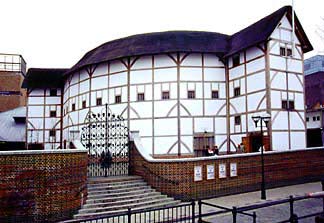 A few weeks ago, while visiting family in England, we took a long overdue visit to see a production at London's new Globe Theatre.
Located in the heart of London's South Bank close to the Thames (just 750 feet away from the location of the original Globe), the Globe plays to a capacity crowd of 1600 twice a day and has, in the fifteen years since it opened, become one of London's most popular tourist destinations. Considering the pride that the British have in Shakespeare you might have thought that a reconstruction of the Globe would have been a "no brainer" project supported by people across the United Kingdom - but that was far from the case. In fact, I hope it will warm the cockles of BookBrowse's mostly American readers to know that the modern-day Globe Theatre would not exist if it wasn't for the vision and determination of one singular American - Sam Wanamaker.
A few weeks ago, while visiting family in England, we took a long overdue visit to see a production at London's new Globe Theatre.
Located in the heart of London's South Bank close to the Thames (just 750 feet away from the location of the original Globe), the Globe plays to a capacity crowd of 1600 twice a day and has, in the fifteen years since it opened, become one of London's most popular tourist destinations. Considering the pride that the British have in Shakespeare you might have thought that a reconstruction of the Globe would have been a "no brainer" project supported by people across the United Kingdom - but that was far from the case. In fact, I hope it will warm the cockles of BookBrowse's mostly American readers to know that the modern-day Globe Theatre would not exist if it wasn't for the vision and determination of one singular American - Sam Wanamaker.
But before getting to that, let's step back in time to the original Globe Theatre, built in 1599 on London's Bankside, in the heart of what is now known as The South Bank. The first Globe was constructed mainly from timbers dismantled from a previous theatre that was built in Shoreditch (North of the Thames), and would likely have stayed there if it wasn't for a greedy landlord who, when the 21-year-lease on the land expired, refused to extend the lease and claimed the building as his own saying that he would put the wood and timber of the building "to better use." The landlord did not have the upper hand for long - he left London for a few days in late December 1598 and while he was away the theatre's carpenter, supported by the players and friends, dismantled the building piece by piece and transported the entire structure to a nearby warehouse! The following Spring, when the weather improved, the beams from the original building were used in the construction of the Globe in the borough of Southwark, on marshy land close to both open fields and the congested south bank of the River Thames. Some scholars think that The Globe was completed in the Summer of 1599 in time for the first production of Henry V, but it would seem that the majority think it was more likely completed by the Autumn, in time for the opening performance of Julius Caesar.
The Globe, said to be the most magnificent theatre that London had ever seen, welcomed crowds of theatre goers (who, it is also said, had the opportunity to avail themselves of other attractions such as the in-house brothel) until the summer of 1613 when a theatrical cannon misfired setting alight the wooden beams and thatching. Miraculously, it seems no one was hurt except for one man whose breaches caught on fire, but he was saved from further injury by the judicious application of a bottle of ale that put out the flames. The modern Globe has copious fire safety features but, based on the liberal quantities of beer among the audience the night we visited, the crowd was clearly ready to tackle a sizeable blaze if the need arose.
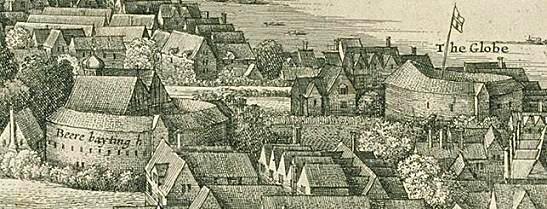
(The image above is a 1642 sketch of the second Globe, after it had been rebuilt following the fire. Apparently the artist, Wenceslas Hollar, incorrectly labeled the buildings - the Globe theatre is not the building indicated but the one labeled "Beere bayting"!)
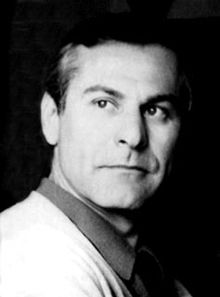 Fast forward to 1949. Enter stage left Sam Wanamaker - the thirty-year-old son of Ukrainian Jewish immigrants from Chicago, Illinois - who, while filming in England, decides to visit the site of the famous theatre that had inspired him ever since he'd seen a half-scale reconstruction of the Globe at the 1934 World's Fair. But all he finds is a measly sign on the wall of a brewery noting that the Globe theatre had stood nearby (the exact location wasn't discovered until 1989). This would likely have been the end of the story if not for events back in the USA which would conspire to return Wanamaker to the UK for the long-term.
Fast forward to 1949. Enter stage left Sam Wanamaker - the thirty-year-old son of Ukrainian Jewish immigrants from Chicago, Illinois - who, while filming in England, decides to visit the site of the famous theatre that had inspired him ever since he'd seen a half-scale reconstruction of the Globe at the 1934 World's Fair. But all he finds is a measly sign on the wall of a brewery noting that the Globe theatre had stood nearby (the exact location wasn't discovered until 1989). This would likely have been the end of the story if not for events back in the USA which would conspire to return Wanamaker to the UK for the long-term.
Sam Wanamaker discovered his love for the theatre early on. He trained at the Goodman Theatre in Chicago, after which he began working with summer stock theatre companies in Chicago and northern Wisconsin, where he was a founding member of the Peninsula Players Theatre in 1937. In 1940 he married Canadian actress Charlotte Holland, and in 1942 made his Broadway debut. From 1943 to 1946 he served in the U.S. Army in the Pacific; after which he moved to Hollywood with the intention of settling there. Which he did for a few years, until Joseph McCarthy, the infamous senator from Wisconsin, arrived on the center of the American political stage with his eye set on any number of dangerous Hollywood subversives, including Wanamaker.
Just before joining the army, Wanamaker had joined the American Communist Party but had given up his membership in 1947 before moving to Hollywood. In 1952, at the height of "the Red Scare", Wanamaker came to England to film Mr Denning Drives North knowing that he might be subpoenaed before the House Committee on Un-American Activities. When he got the news that he would be, rather than returning to Washington to confess his errors and inform on his colleagues, he chose to stay in England where his family soon joined him, having quietly put their house into storage. Shortly after he was blacklisted (banned from working in Hollywood) and his American passport was revoked.
Wanamaker went on to establish a career as an actor, director and producer in Britain. In 1957, he was appointed director of the New Shakespeare Theatre, Liverpool; and in 1959 joined the Shakespeare Memorial Theatre company at Stratford-upon-Avon (where, in 1959, he played Iago to Paul Robeson's Othello; Robeson was also a casualty of blacklisting). During the 1960s and '70s, he produced or directed several works at Covent Garden in London, and elsewhere, including the Shakespeare Birthday Celebrations in 1974. He worked both as director and actor in films and television in the UK and, later (presumably with his reputation cleared) in the USA. His acting roles include parts in The Spiral Staircase, Private Benjamin, Superman IV, The Spy Who Came in From the Cold, Baby Boom and Guilty by Suspicion.
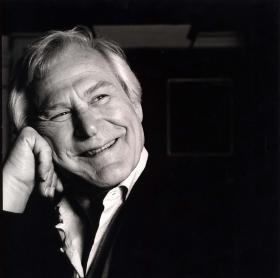
It was Wanamaker who established the Globe Playhouse Trust in 1970 as an educational charity in order to raise the funds to build a replica theatre. It was Wanamaker who persuaded the hostile Southwark council to provide a 1.2 acre site for the project close to the original theatre. It was Wanamaker who invested his own limited earnings as an actor and director into the trust in order to pay for architectural research and drawings. It was Wanamaker who nursed the project through the next twenty years of red tape, fund-raising deadlines, false starts, ridicule and skepticism, until eventually the building work began in 1991.
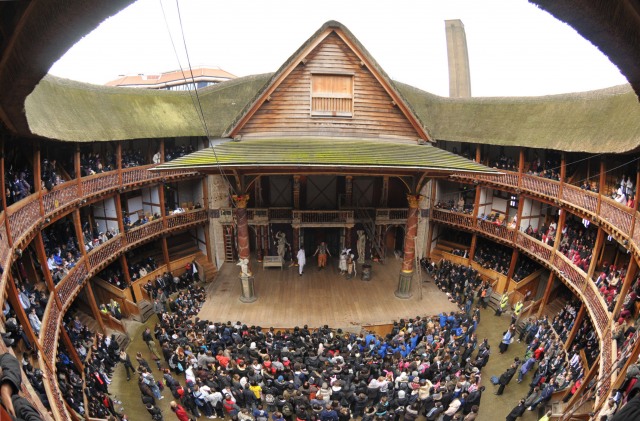 Sam Wanamaker died in December 1993 following a five-year fight against prostate cancer. Shortly before he died he watched the first performance in the Globe on a temporary stage in the partially built theatre. More than 700 actors filled his memorial service in Southwark Cathedral - to say goodbye to a friend and to honor a visionary. At last, after so many years, opinion had swung in favor of the project, but the completion of the theatre was still in serious doubt due to lack of funds. In 1995 The National Lottery (the UK's state-franchised lottery which has raised more than £20 billion for "good causes" since 1994) donated £12.4 million to the Globe Trust enabling the completion of the theatre and ancillary facilities. Finally, in 1996, the Globe officially opened and both the public and the accolades started to pour in.
Sam Wanamaker died in December 1993 following a five-year fight against prostate cancer. Shortly before he died he watched the first performance in the Globe on a temporary stage in the partially built theatre. More than 700 actors filled his memorial service in Southwark Cathedral - to say goodbye to a friend and to honor a visionary. At last, after so many years, opinion had swung in favor of the project, but the completion of the theatre was still in serious doubt due to lack of funds. In 1995 The National Lottery (the UK's state-franchised lottery which has raised more than £20 billion for "good causes" since 1994) donated £12.4 million to the Globe Trust enabling the completion of the theatre and ancillary facilities. Finally, in 1996, the Globe officially opened and both the public and the accolades started to pour in.
In 2003, Zoë Wanamaker, one of Sam's three children and one of Britain's favorite actresses, unveiled a blue plaque recognizing her father (blue plaque's are permanent historical markers that have been used across Britain to commemorate a link between a particular location and a famous person since the 1860s). The plaque reads:
Sam Wanamaker 1919-1993
Visionary who recreated Shakepeare's Globe
Voted by the People
In Thanksgiving for Sam Wanamaker,
Actor, Director, Producer, 1919-1993,
whose vision rebuilt Shakespeare's Globe Theatre
on Bankside in this parish.